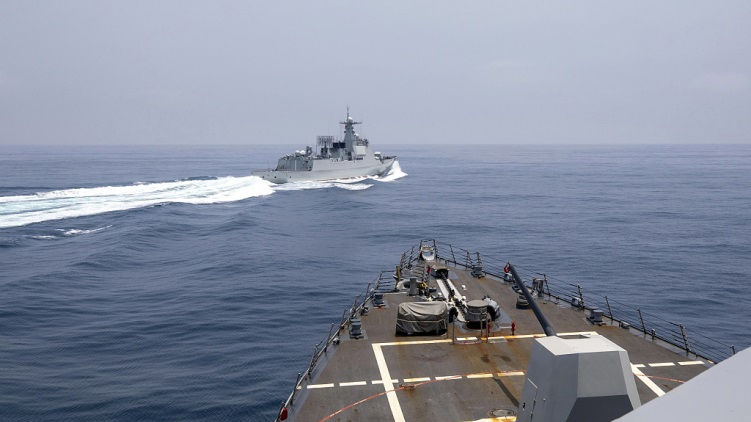
A Chinese navy ship in the Taiwan Straits, June 3, 2023. /CFP
A Chinese navy ship in the Taiwan Straits, June 3, 2023. /CFP
Editor's note: Bradley Blankenship, a special commentator on current affairs for CGTN, is a Prague-based American journalist, political analyst and freelance reporter. The article reflects the author's opinions and not necessarily the views of CGTN.
Journalists aboard Navy warships released footage of the moment that a Chinese warship zoomed past the USS Chung-Hoon on a "routine patrol" in the Taiwan Straits on Saturday. That footage, which did not show a proper angle, seemed to rouse serious suspicion of the Chinese vessel acting provocatively but then the U.S. Navy itself released a video that showed it was not as serious as the media portrayed.
According to the Navy, the Chinese ship crossed in front of the U.S. ship's bow at 150 yards. For reference, that is one and a half National Football League fields, or much further than the howitzer cannons installed on quarterbacks Patrick Mahomes or Josh Allen could ever throw. It was, to put it plainly, pretty far and not in any way signs that a Chinese warship intended to ram into an American one, as some folks have suggested. It certainly wasn't "dangerously close," as Politico's defense editor Dave Brown described it as.
However, what was "dangerously close" in this entire interaction was a U.S. warship in China's territorial waters. That is to say that these Navy ships are pretty far from U.S. sovereign territory and it begs the question, what the heck are they doing all the way over there?
Well, according to the Navy, this was a joint patrol by the U.S. and Canada that was "in accordance with international law." The Navy said that "Chung-Hoon and Montreal's transit through the Taiwan Straits demonstrates the combined U.S.-Canadian commitment to a free and open 'Indo-Pacific'" and that the "U.S. military flies, sails and operates safely and responsibly anywhere international law allows."

An island in the Taiwan Straits, China, September 28, 2021. /VCG
An island in the Taiwan Straits, China, September 28, 2021. /VCG
But does international law really allows the U.S. to sail or fly its war machines just a few hundred kilometers from Chinese mainland's coast in Fujian Province and through its territorial waters? A recent analysis from the South China Sea Strategic Situation Probing Initiative (SCSPI) written by Lei Xiaolu of Wuhan University and republished in Xinhua journalist Wang Zichen's Pekingnology newsletter explains why the U.S. interpretation of "freedom of navigation" is significantly different from the one written under international law.
There are a few important points in this analysis to note that I think are most important. Number one, there is no such thing as the "unrestricted right of navigation in the Convention (the United Nations Convention on the Law of the Sea) or in general international law." The U.S. clearly contends that its warships, aircraft and submarines should have total access to the world's waterways but neither the international law nor the relevant Convention which articulates this support this interpretation.
Number two, while ships of foreign countries can enjoy the right of "innocent passage" in territorial sea, Article 25 of the Convention says that states can take measures to prevent passage that isn't innocent. And states have the right to decide what constitutes innocent passage, having the ability to enact domestic laws to define this and requirements for foreign warships that disregard innocent passage to leave their territorial sea immediately. So, in a nutshell, there is obviously no right of navigation for ships that ignore a state's decisions over their territorial waters.
Finally, the Convention, in accordance with Articles 31 and 32 of the Vienna Convention on the Law of Treaties, should be interpreted based on the subsequent practice of its parties. The U.S. is not a party to either the United Nations Convention on the Law of the Sea or the Vienna Convention, meaning that it has no legal claim to establish precedents based on its own practices. The U.S. has repeatedly tried to claim this – but it is wholly inconsistent with international law.
In fact, the Navy's entire justification for its ships being in the Taiwan Straits is illegal under international law. The U.S. does not have any right to patrol the Straits with its Navy. If the U.S. were to invoke permission from China's Taiwan region as a justification, this would be null since Taiwan is not a UN-recognized state nor, officially, a U.S.-recognized state and thus not able to give such permission. So, in this entire debacle, Chinese ships were not "dangerously close" to U.S. ships; U.S. ships were actually dangerously far from where they are legally permitted to be.
(If you want to contribute and have specific expertise, please contact us at opinions@cgtn.com. Follow @thouse_opinions on Twitter to discover the latest commentaries in the CGTN Opinion Section.)